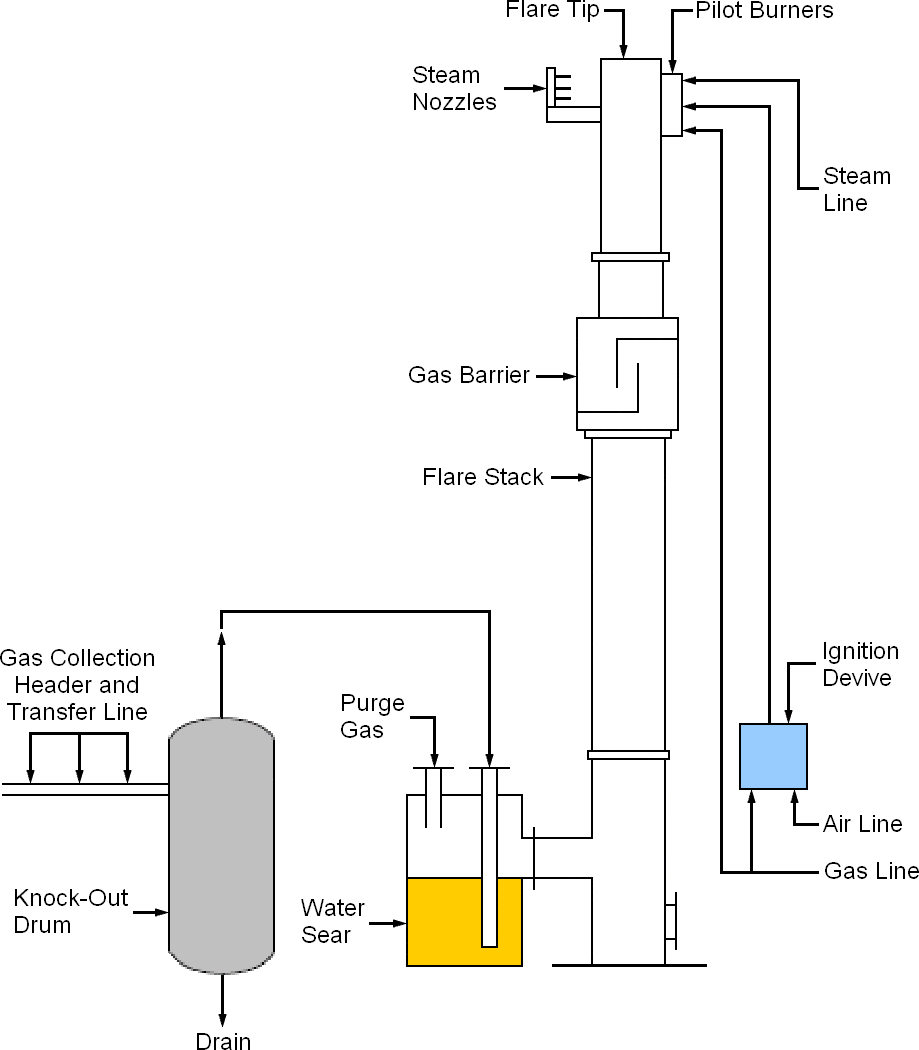 |
Flaring in Industry |
A gas flare, alternatively known as a flare stack
Is a important safety device used in refineries and petrochemical facilities. They safely burn excess hydrocarbon gases which cannot be recovered or recycled. Excess hydrocarbon gases are burnt in the flare systems in an environmentally-sound manner, as an alternative to releasing the vapour directly into the atmosphere.
During flaring, excess gases are combined with steam and/or air, and burnt off in the flare system to produce water vapour and carbon dioxide. The process of burning these excess gases is similar to the burning of liquefied petroleum gases (LPG), which some of us use as fuel for home cooking.
The use of flares is minimised to the extent that is possible. However, flaring can occur during a start-up and shut-down of any of our facilities for maintenance, and also during unplanned operational interruptions such as power outages.
When there is flaring promptly inform the neighbouring companies and Government agencies.
There are generally two types of flares that we use at manufacturing facilities..
- Elevated flares, where the flare tip is between 20 to 150 meters above ground.
- Ground flares, where the flare tip is about two to three meters above ground, which is fenced off with a high heat-shield fencing, which also acts as a safety zone.
What can sometimes be seen or heard in instances of flaring..
A flame or a glow..
- Members of the public may become concerned when they see flaring and mistake them for fires.
- The elevated flare presents itself as a flame.
- The ground flare is not visible in the day. At night, it may cast an orange glow in the night sky, depending on cloud cover.
Noise..
- Flaring may produce a rumbling noise. It may sound like thunder.
- This is due to the turbulent mixing of gases, air and steam. The sound is similar to what you hear when you fan a campfire, and oxygen is mixed with the flame.
Smoke..
- Sometimes, a white cloud may be observed around the flare. It is actually steam that is injected into the flare system to support clean combustion.
- While we strive to achieve smokeless flaring, it may not always be possible during operational situations.
- On some occasions, there may be black smoke from the flare.
- The smoke, which is mainly made up of carbon particles, occurs when there is insufficient amount of air to support a complete combustion. This may happen when there is a sudden release of excess gases to the system with a delay in response before sufficient steam can be supplied to the burning process.
- Steam is usually added to the gases to increase turbulence in the gas flow. This increases air intake that helps to achieve complete combustion and smokeless flaring.
When you see flaring, please be assured that flares play a key role in keeping refineries and chemical plants running safely.
Schematic image of a Steam assisted Flare System

Definition
Gas Blower - Device for blowing air to flare system.
Flare System - A system that safely disposing of waste gases through the use of combustion.
Flare Stack - Is an elevated vertical stack found on oilwells or oil rigs, and in refineries, chemical plants and landfills used for burning off unusable waste gas or flammable gas and liquids released by pressure relief valves during unplanned over-pressuring of plant equipment.
Flare Tips - Structure at top of the flare play the role to keep an optimum burn and control over all flow rates, which results in a cleanercombustion. The design of the tip makes sure that the tip does not come into contacting with the flame making the tips reliable and long lasting.
Ignitions system - Is a system use to ignite the flare of flare systems. Normally this system designed to ignite the flare quickly the first time, maintain combustion and reignite rapidly to prevent industrial hazards and personal injury while protecting the environment.
Knockout Drum - Is a drum installed near the flare base, and serves to recover liquid hydrocarbons, prevent liquid slugs, and remove large liquid particles from the gas streams released from relief system.
Support Structure - Structure which designed to withstand local wind condition for flares. Three types available self-supported, Guy-wire supported and Derrick supported.
Windbreaker - A windbreaker is structure uses to prevent the wind from extinguishing the flames which located at flare tip. It serves also to hide the flames.
Related Post(s)

During flaring, excess gases are combined with steam and/or air, and burnt off in the flare system to produce water vapour and carbon dioxide...
